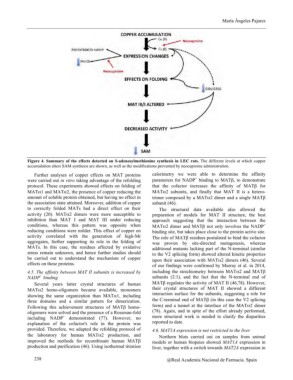Page 124 - 82_02
P. 124
María Ángeles Pajares
Figure 4. Summary of the effects detected on S-adenosylmethionine synthesis in LEC rats. The different levels at which copper
accumulation alters SAM synthesis are shown, as well as the modifications prevented by neocuproine administration.
Further analyses of copper effects on MAT proteins calorimetry we were able to determine the affinity
were carried out in vitro taking advantage of the refolding parameters for NADP+ binding to MATß, to demonstrate
protocol. These experiments showed effects on folding of that the cofactor increases the affinity of MATß for
MATa2 subunits, and finally that MAT II is a hetero-
MATa1 and MATa2, the presence of copper reducing the trimer composed by a MATa2 dimer and a single MATß
amount of soluble protein obtained, but having no effect in subunit (46).
the association state attained. Moreover, addition of copper
to correctly folded MATs had a direct effect on their The structural data available also allowed the
preparation of models for MAT II structure, the best
activity (20). MATa2 dimers were more susceptible to approach suggesting that the interaction between the
inhibition than MAT I and MAT III under reducing MATa2 dimer and MATß not only involves the NADP+
conditions, whereas this pattern was opposite when binding site, but takes place close to the protein active site.
reducing conditions were milder. This effect of copper on
activity correlated with the generation of high-Mr The role of MATß residues postulated to bind the cofactor
aggregates, further supporting its role in the folding of was proven by site-directed mutagenesis, whereas
MATs. In this case, the residues affected by oxidative additional mutants lacking part of the N-terminal (similar
stress remain unknown, and hence further studies should to the V2 splicing form) showed altered kinetic properties
be carried out to understand the mechanism of copper
effects on these proteins. upon their association with MATa2 dimers (46). Several
of our findings were confirmed by Murray et al. in 2014,
4.5. The affinity between MAT II subunits is increased by
NADP+ binding including the stoichiometry between MATa2 and MATß
subunits (2:1), and the fact that the N-terminal end of
Several years latter crystal structures of human
MATa2 homo-oligomers became available, monomers MATß regulates the activity of MAT II (46,78). However,
showing the same organization than MATa1, including their crystal structures of MAT II showed a different
three domains and a similar pattern for dimerization. interaction surface for the subunits, suggesting a role for
Following this achievement structures of MATß homo- the C-terminal end of MATß (in this case the V2 splicing
oligomers were solved and the presence of a Rossman-fold form) and a tunnel at the interface of the MATa2 dimer
including NADP+ demonstrated (77). However, no (78). Again, and in spite of the effort already performed,
explanation of the cofactor's role in the protein was more structural work is needed to clarify the disparities
provided. Therefore, we adapted the refolding protocol of reported to date.
the laboratory for human MATa2 production, and 4.6. MAT1A expression is not restricted to the liver
improved the methods for recombinant human MATß
production and purification (46). Using isothermal titration Northern blots carried out on samples from animal
models or human biopsies showed MAT1A expression in
liver, together with a switch towards MAT2A expression in
238 @Real Academia Nacional de Farmacia. Spain

